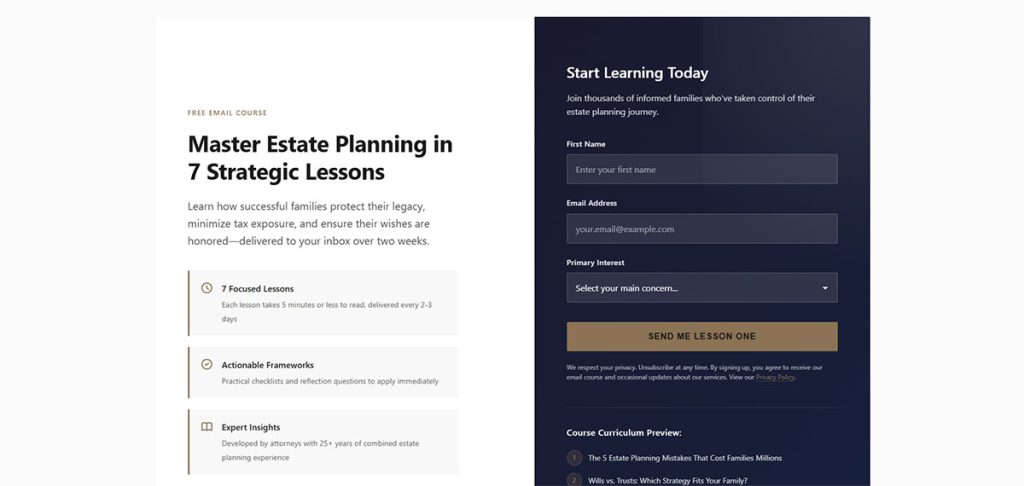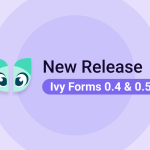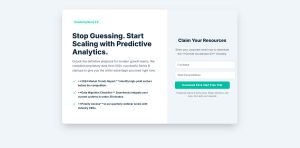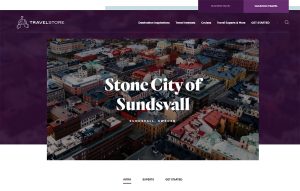Empty treadmills don’t pay bills. Fitness centers compete against Planet Fitness, Anytime Fitness, and boutique studios on every corner. Lead generation for gyms separates the survivors from the closures. The…
Table of Contents
Your phone rings at 3 PM on a Tuesday. Another consultation that goes nowhere.
Lead magnets for law firms solve a problem most attorneys don’t talk about: most prospects aren’t ready to hire when they first find you. They’re researching, comparing options, trying to understand if they even need legal help.
But those “not ready yet” prospects? They become tomorrow’s paying clients if you stay in front of them.
This guide breaks down twenty proven lead generation strategies that capture contact information from website visitors before they disappear to a competitor’s site. You’ll see what works for different practice areas, how much effort each approach requires, and which formats convert browsers into consultations.
Free resources build your email list. Email lists become client relationships. Client relationships generate revenue and referrals that compound for years.
Lead Magnets For Law Firms
| Lead Magnet Type | Implementation Complexity | Conversion Intent Level | Time-to-Value Delivery |
|---|---|---|---|
| Free Consultation | Low – requires scheduling infrastructure and attorney availability management | High – direct attorney-client dialogue indicates immediate legal need | Immediate – synchronous interaction provides instant professional assessment |
| Legal Guide/Ebook | Medium – requires substantive legal research, writing, and design production | Medium – educational content consumption suggests research phase behavior | Instant – asynchronous digital delivery enables self-paced information access |
| Checklist | Low – single-page actionable item list with minimal design requirements | Medium – procedural guidance indicates task-oriented legal preparation | Instant – immediately actionable steps provide rapid practical utility |
| Template Documents | Medium – jurisdiction-specific legal language with compliance verification needed | Medium-High – document need signals active legal matter progression | Instant – customizable framework accelerates document preparation process |
| Webinar | High – live presentation production, technical platform, and promotion strategy | Medium – scheduled attendance demonstrates interest but delayed conversion window | Delayed – fixed-time event creates registration-to-value gap of days or weeks |
| Case Evaluation | Low – form submission with attorney review workflow and response protocol | Very High – case-specific details submission indicates active representation pursuit | Short Delay – asynchronous review requires 24-48 hour professional analysis turnaround |
| Newsletter Subscription | Low – email service platform integration with regular content publishing cadence | Low – passive information consumption indicates awareness-stage positioning | Continuous – recurring delivery maintains ongoing relationship development |
| Legal Quiz/Assessment | Medium – interactive question logic with personalized result generation algorithm | Medium – self-assessment behavior reveals situation awareness and solution seeking | Instant – automated scoring provides immediate personalized feedback delivery |
| Video Tutorial Series | High – multi-episode production requiring filming, editing, hosting, and sequencing | Low-Medium – educational content series suggests early research and learning phase | Extended – multi-part consumption creates gradual value accumulation over time |
| Whitepaper | High – authoritative research document with citations, data analysis, and formatting | Low – academic-style content attracts researchers or industry professionals primarily | Instant – comprehensive reference document available for immediate deep analysis |
| FAQ Guide | Low – question-answer format compilation from common client inquiries | Medium – specific question seeking demonstrates targeted information need | Instant – scannable format enables rapid answer location and comprehension |
| Court Process Flowchart | Medium – visual representation of procedural steps with jurisdiction-specific accuracy | Medium – process understanding need indicates potential litigation involvement | Instant – visual navigation diagram provides quick procedural orientation |
| Rights Infographic | Medium – graphic design production combining legal accuracy with visual communication | Low-Medium – rights awareness seeking suggests general legal education interest | Instant – visual summary format delivers rapid comprehension of key concepts |
| Legal Toolkit | High – bundled resource collection including multiple documents, templates, and guides | Medium-High – comprehensive resource need indicates serious legal matter handling | Instant – complete resource package enables immediate multi-faceted problem approach |
| Sample Contracts | Medium – legally-vetted example agreements with explanatory annotations required | Medium – contract review need suggests active transaction or agreement negotiation | Instant – reference document provides immediate contractual language examples |
| Statute of Limitations Calculator | Medium – jurisdiction-specific deadline computation with case-type variables | High – deadline urgency assessment indicates potential claim filing consideration | Instant – automated calculation provides immediate time-sensitive deadline determination |
| Case Study Collection | Medium – anonymized client success narratives with outcome documentation and analysis | Medium – outcome research behavior demonstrates attorney performance evaluation phase | Instant – precedent examples provide immediate firm capability demonstration |
| Email Course | Medium – sequential lesson planning with automated drip delivery system configuration | Low-Medium – structured learning commitment indicates educational goal over immediate need | Extended – multi-day sequential delivery builds knowledge incrementally over course duration |
| Podcast Series | High – audio recording production, editing, hosting platform, and distribution strategy | Low – passive audio consumption suggests brand awareness building over conversion | Extended – episodic listening creates ongoing engagement across multiple sessions |
| Legal Blog Access | Low – content management system with regular article publishing workflow | Low – general interest browsing indicates early awareness or information gathering | Continuous – ongoing content updates maintain persistent information resource availability |
Free Consultation
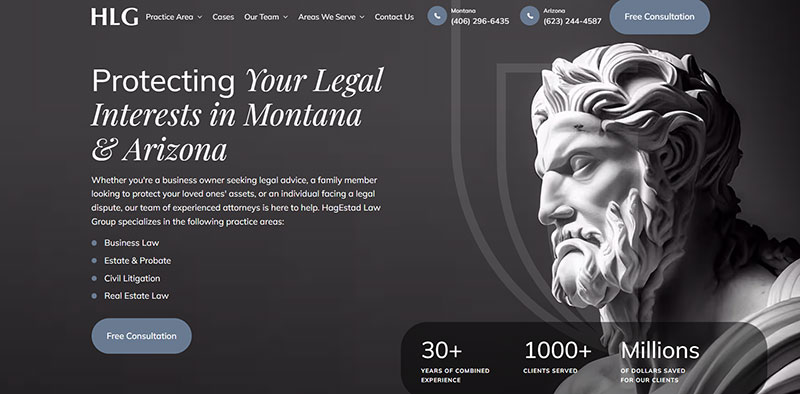
Image source: hagestadlaw.com
Most law firms already do this. But fewer than half actually track conversion properly.
Target Audience
Qualified prospects ready to discuss their legal issues immediately. Works best for personal injury clients, family law situations, criminal defense cases, and business litigation needs.
Content Format
Phone-based consultations, video calls, or in-person meetings scheduled through online booking systems. Some firms offer 15-minute quick assessments while others provide full 60-minute strategy sessions.
Value Proposition
Removes financial barriers for prospects evaluating legal representation. Research shows that firms responding to consultation requests within five minutes convert leads 21 times more effectively than those waiting 30 minutes or longer.
Implementation Complexity
Minimal technical setup required but demands significant attorney time investment. Proper intake systems and professional scheduling tools matter more than most attorneys realize.
You’ll need staff trained to qualify leads, calendar management software, and follow-up email sequences ready to deploy.
Conversion Mechanism
Landing pages designed specifically for legal services typically convert at 6.3% according to 2024 benchmarks. Place consultation offers prominently on practice area pages with clear calls to action.
Follow-up proves critical since only 30-33% of prospects retain counsel at first consultation. Set up nurture campaigns for those who don’t sign immediately.
Practice Area Fit
Universal application across all practice areas. Personal injury and family law typically see highest consultation-to-client conversion rates, while complex business matters may require longer consideration periods.
Legal Guide or Ebook
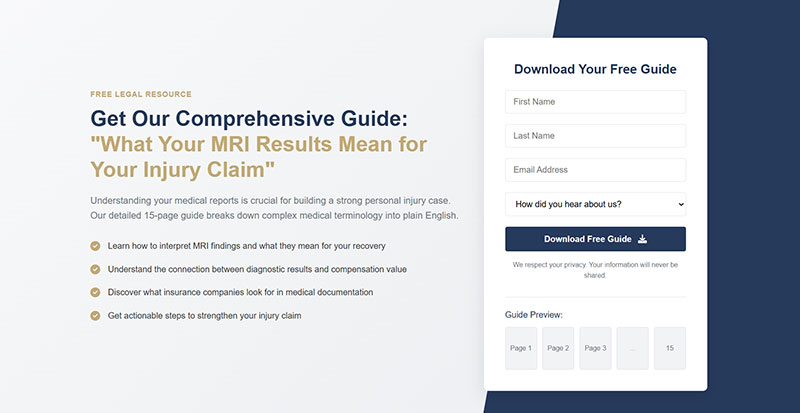
Standard approach that many firms get wrong. Length matters less than relevance.
Target Audience
Information-seekers early in their decision process. People googling “what to do after car accident” or “divorce process in California” represent your core audience.
Estate planning prospects, small business owners researching formation options, and individuals assessing whether they need legal help at all.
Content Format
Downloadable PDF guides ranging from 8-25 pages work best. According to content marketing research, 59% of prospects prefer this format for legal information.
Keep it scannable with headers, bullet points, and visual breaks.
Value Proposition
Positions your firm as trusted authority before prospects speak with any attorney. Most valuable when addressing specific questions that bring people to search engines in the first place.
But here’s the problem: generic guides about “understanding personal injury law” get ignored. Specific guides about “what your MRI results mean for your injury claim” get downloaded.
Implementation Complexity
Moderate effort required. Writing takes 8-15 hours for quality content, plus design work and technical setup for gated content delivery.
You can repurpose existing blog content, combine multiple posts around one theme, and hire freelance designers on platforms like Canva or Upwork for under $200.
Conversion Mechanism
Gate the content behind an email capture form. Add the ebook offer to relevant blog posts as upgrades. Promote through social media and paid advertising.
Email sequences following the download should provide additional value before pitching consultation.
Practice Area Fit
Estate planning, immigration law, and business formation see strongest performance. These practice areas involve complex processes that prospects need to understand before hiring representation.
Checklist
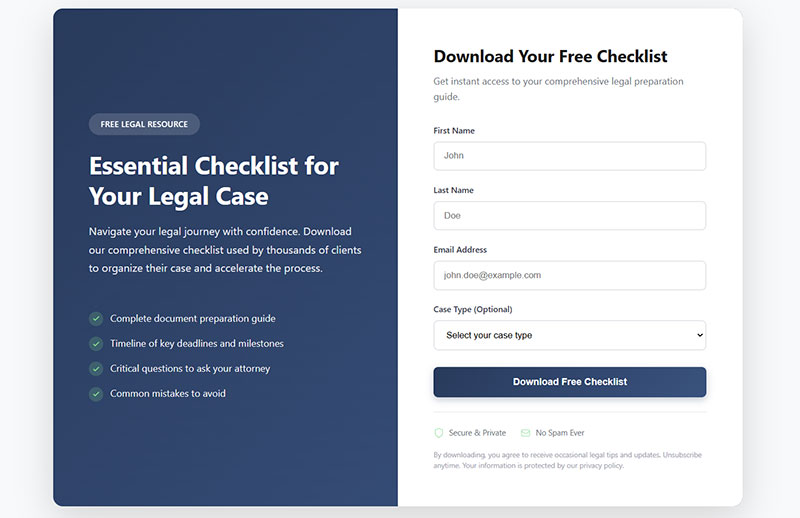
Converts better than any other lead magnet type when done right. Simple beats comprehensive here.
Target Audience
Action-oriented prospects who need immediate guidance. People searching “what documents do I need for disability claim” or “divorce preparation checklist” want quick answers.
Works particularly well for prospects already decided on taking legal action but uncertain about next steps.
Content Format
One-page printable PDF or interactive web-based checklist. Between 8-15 actionable items provides optimal length without overwhelming users.
Include checkboxes, space for notes, and clear sequencing.
Value Proposition
Provides immediate practical value that prospects can use today. Checklists feel easier to consume than long guides, which increases download rates significantly.
They also tend to get shared more frequently than other content types.
Implementation Complexity
Low barrier to entry. Most checklists can be created in 2-4 hours including design work.
Start by listing what you ask clients to bring or prepare for consultations. Turn that into a structured checklist prospects can use independently.
Conversion Mechanism
Same gating strategy as ebooks but with higher conversion rates. Promote checklists in the sidebar of relevant blog content or as exit-intent offers.
Simple designs work better than over-designed versions trying too hard to look premium.
Practice Area Fit
Immigration (visa application checklists), family law (divorce document preparation), personal injury (evidence collection after accident), and estate planning (will preparation checklist) all perform well.
Criminal defense benefits from “what to do if arrested” checklists.
Template Documents
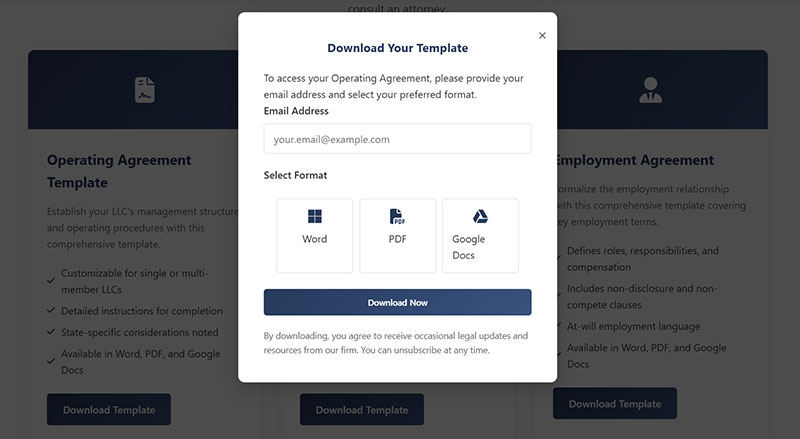
High perceived value but requires careful legal disclaimers.
Target Audience
Small business owners, individuals handling straightforward legal matters independently, and prospects researching whether they need attorney assistance.
DIY-oriented people who may eventually realize they need professional help after attempting self-service approach.
Content Format
Editable Word documents, Google Docs templates, or fillable PDF forms. Include detailed instructions for completion and prominent disclaimers about when professional legal counsel becomes necessary.
Value Proposition
Provides tangible tools prospects can actually use. Templates demonstrate your understanding of client needs while showcasing the complexity that often requires attorney guidance.
Many who download templates later hire attorneys anyway after realizing the work involved.
Implementation Complexity
Moderate to high depending on template complexity and jurisdiction considerations. Legal review is required before distribution to ensure compliance and limit liability.
Templates need regular updates when laws change. Budget 10-20 hours for initial creation plus annual review time.
Conversion Mechanism
Strong lead qualification occurs naturally since people downloading specific templates (like operating agreements or prenuptial agreement outlines) show clear intent around particular services.
Follow-up sequences should highlight when DIY approaches become risky.
Practice Area Fit
Business law (operating agreements, basic contracts), estate planning (healthcare directive templates), landlord-tenant law, and employment law all work well with template strategies.
Avoid creating templates for practice areas where mistakes carry severe consequences.
Webinar
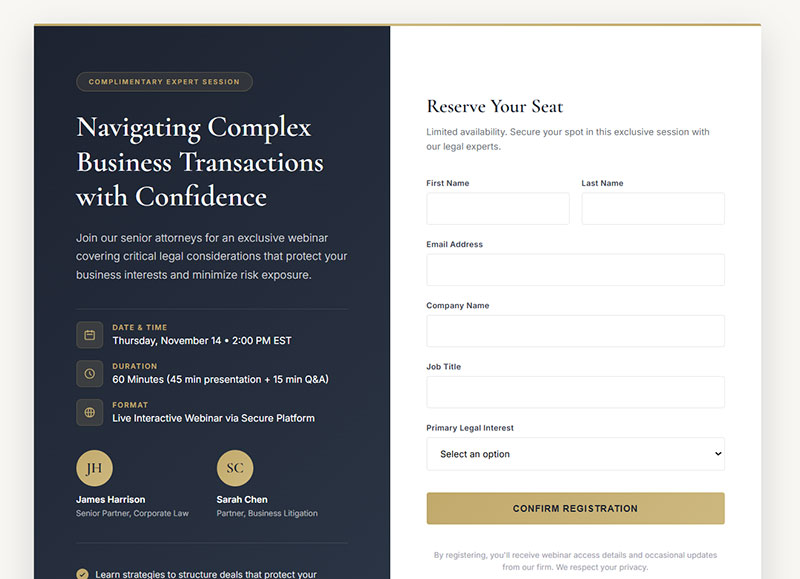
Expensive to produce but generates highly qualified leads when targeting is precise.
Target Audience
Prospects willing to invest 30-60 minutes learning from attorneys. Business clients, individuals facing major legal decisions, and referral sources all respond well to webinar invitations.
Professional audiences (HR managers, small business owners, real estate agents) often attend industry-specific legal webinars.
Content Format
Live or pre-recorded video presentations with Q&A component. 45 minutes of content plus 15 minutes for questions works well.
Platforms like Zoom, WebinarJam, or Demio handle registration and delivery.
Value Proposition
Face-to-face interaction builds trust faster than written content. Prospects see attorney communication style, expertise level, and personality before scheduling consultations.
According to marketing effectiveness research, webinars for law firms deliver highly qualified attendees compared to passive content downloads.
Implementation Complexity
High initial investment. Planning topics, creating presentations, marketing the event, and managing live delivery requires 20-40 hours for first webinar.
Technical requirements include reliable internet, decent webcam and microphone, presentation software, and webinar platform subscription.
Conversion Mechanism
Registration captures contact information. Post-webinar follow-up matters more than the event itself. Studies show only 20% of webinar registrants convert immediately, but persistent follow-up increases that significantly.
Recorded webinars become ongoing lead generation assets.
Practice Area Fit
Business law, employment law for employers, estate planning, and medical malpractice work exceptionally well. Complex practice areas where education reduces prospect anxiety show best ROI.
Case Evaluation
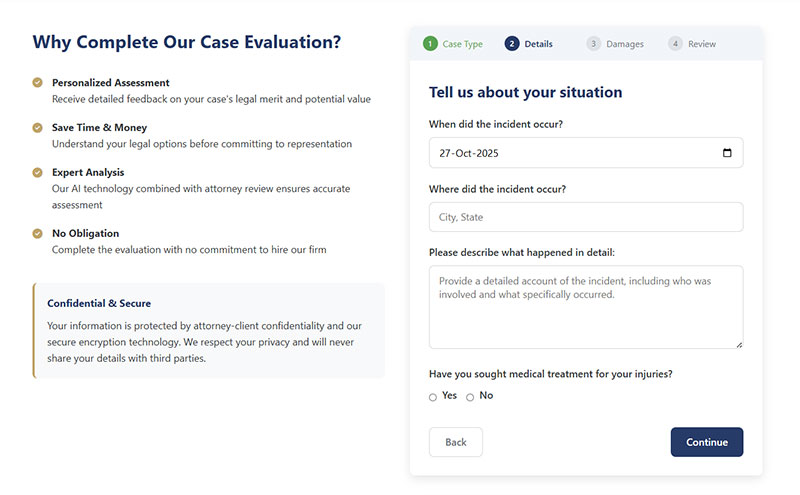
Direct assessment that qualifies leads immediately while providing personalized value.
Target Audience
Prospects with specific legal situations needing professional assessment. Personal injury victims, potential whistleblowers, product liability claimants, and medical malpractice victims particularly value detailed case evaluations.
Content Format
Structured online questionnaires collecting case details, circumstances, damages, and documentation. Can be simple forms or sophisticated multi-step assessments with conditional logic.
Some firms offer AI-powered preliminary assessments followed by attorney review.
Value Proposition
Personalized feedback on case viability and potential outcomes. Prospects receive preliminary assessment of their situation’s legal merit, estimated timelines, and potential case value ranges.
Dramatically reduces time wasted on unqualified leads while giving strong prospects immediate value.
Implementation Complexity
Moderate to high. Building effective assessment tools requires understanding which information predicts case viability.
Multi-step forms with branching logic work best but need proper setup. Budget time for attorney review of submissions if offering personalized responses.
Conversion Mechanism
Detailed case information collected upfront makes follow-up calls highly personalized. Conversion rates from case evaluation to retained client typically exceed generic consultation requests by 15-25%.
Automated initial responses can acknowledge submission immediately while promising detailed review within 24 hours.
Practice Area Fit
Personal injury, workers’ compensation, Social Security disability, medical malpractice, and product liability cases benefit most. Practice areas with clear case acceptance criteria make evaluation feasible at scale.
Newsletter Subscription

Longest-term nurture strategy with lowest immediate conversion but highest lifetime value.
Target Audience
Anyone interested in legal topics relevant to your practice. Current clients, referral sources, prospects not ready to hire, and industry professionals all make valuable subscribers.
Content Format
Regular email newsletters (weekly, biweekly, or monthly) containing legal updates, case results, firm news, and educational content.
Plain text emails often outperform heavily designed versions in legal industry.
Value Proposition
Keeps firm top-of-mind when legal needs arise. Email marketing delivers $42 ROI for every $1 spent according to industry research, making it most cost-effective long-term channel.
Implementation Complexity
Low setup complexity but requires ongoing content creation commitment. Email service provider subscription needed (Mailchimp, ConvertKit, or legal-specific platforms).
Consistency matters more than frequency. Pick sustainable schedule and maintain it.
Conversion Mechanism
Newsletter subscriptions rarely convert immediately but significantly increase lifetime referral value and client retention. Open rates for law firm newsletters average 22%, well above most industries.
Track which content drives consultation bookings to refine topics over time.
Practice Area Fit
Universal application. Estate planning and business law particularly benefit from regular touchpoints since client needs evolve over years.
Legal Quiz or Assessment
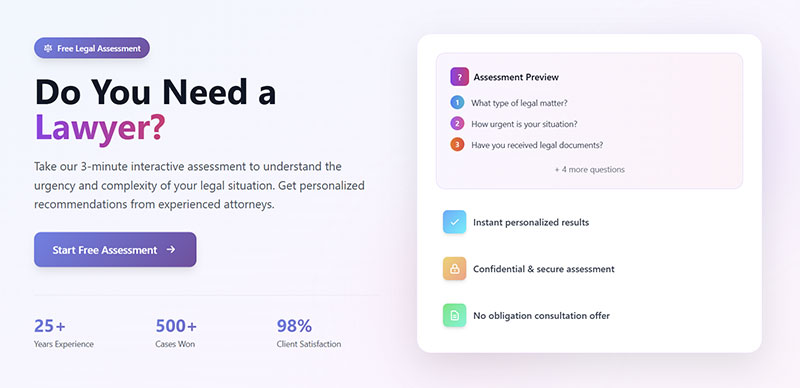
Interactive format with higher engagement but lower completion rates than passive content.
Target Audience
Prospects uncertain whether they need legal help. People searching “do I need a lawyer for…” or “is my situation serious enough for attorney” benefit from self-assessment tools.
Works well for prospects early in research phase.
Content Format
Interactive online quiz (10-15 questions) with personalized results. Tools like Typeform, Outgrow, or WordPress quiz plugins handle delivery.
Results should provide actionable insights regardless of score.
Value Proposition
Entertainment value combined with personalized assessment creates engaging experience. Quizzes get shared on social media more than static content.
Prospects receive immediate feedback about their situation’s urgency and complexity.
Implementation Complexity
Moderate effort required. Developing meaningful questions that provide useful assessment takes legal expertise plus marketing understanding.
Plan for 8-15 hours developing questions, result categories, and technical implementation.
Conversion Mechanism
Email capture can occur before showing results or after (testing recommended). Personalized result pages should include specific next steps and consultation offers tailored to quiz outcomes.
Abandoned quiz recovery sequences can bring back incomplete attempts.
Practice Area Fit
Family law (divorce readiness), business law (entity type selection), estate planning (will complexity assessment), and employment law (wrongful termination evaluation) all work well with quiz formats.
Video Tutorial Series
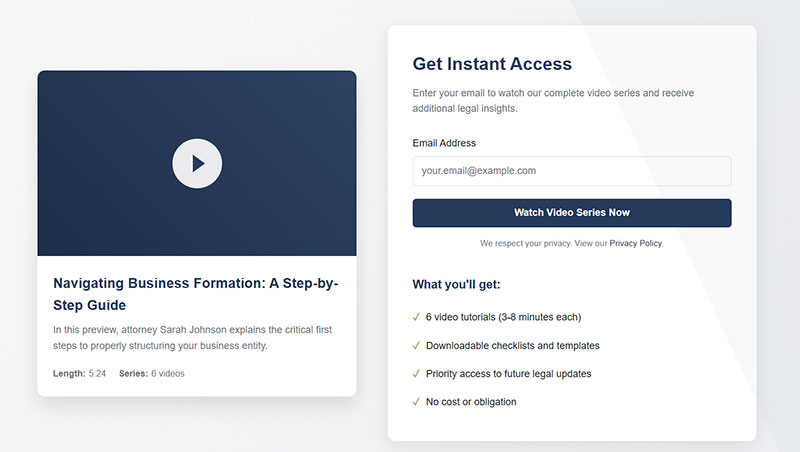
Time-intensive to produce but video content generates 88% more leads according to marketing research.
Target Audience
Visual learners, mobile users, and prospects consuming content during commutes or downtime. Younger demographics particularly prefer video over written content.
Small business owners and busy professionals value condensed video explanations.
Content Format
Short videos (3-8 minutes each) covering specific topics in series format. Host on YouTube, firm website, or specialized video platforms.
Screen recordings with voiceover work for process explanations. Attorney presentations work for educational content.
Value Proposition
Video builds trust faster than written content because prospects see attorney communication style, personality, and expertise demonstrated in real-time.
Series format encourages ongoing engagement rather than one-time consumption.
Implementation Complexity
High initial investment. Video production requires equipment (even just smartphone with good lighting), editing software, and comfort on camera.
First video typically takes 6-10 hours to script, record, and edit. Subsequent videos become faster with experience.
Conversion Mechanism
Video series delivered via email drip campaign keeps prospects engaged over weeks. Include consultation offers at strategic points in series (after establishing sufficient trust and authority).
YouTube videos can drive organic traffic to firm website for years.
Practice Area Fit
Immigration law (visa process explanations), criminal defense (court process walkthroughs), personal injury (insurance negotiation tips), and business law (formation process videos) all perform well.
Whitepaper
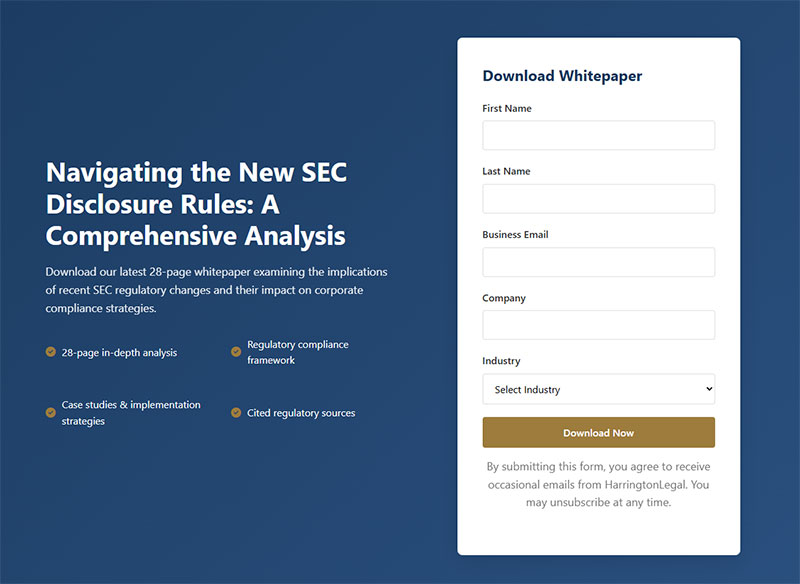
B2B-focused lead magnet demonstrating deep expertise and thought leadership.
Target Audience
Business clients, in-house counsel, referral sources, and sophisticated prospects researching complex legal topics.
Corporate decision-makers, HR professionals, and business owners value detailed analysis over simplified guides.
Content Format
In-depth written analysis (12-30 pages) examining specific legal issues, regulatory changes, or industry trends.
Professional design and rigorous citation practices separate whitepapers from standard guides.
Value Proposition
Positions firm as authoritative voice on specialized topics. Whitepapers demonstrate research depth and analytical capability that sophisticated clients expect.
Can be repurposed for CLE presentations, conference materials, and media commentary.
Implementation Complexity
High effort required. Research, writing, legal review, and design typically consume 30-60 hours for quality whitepaper production.
May require collaboration between multiple attorneys for technical accuracy.
Conversion Mechanism
Promoted through LinkedIn, industry publications, email to existing database, and targeted advertising to business audiences.
Follow-up sequences should acknowledge sophisticated audience and avoid overly aggressive sales language.
Practice Area Fit
Corporate law, employment law for employers, securities law, healthcare law, intellectual property, and regulatory compliance practices benefit most from whitepaper strategies.
Consumer-focused practices rarely see sufficient ROI from whitepaper investment.
FAQ Guide
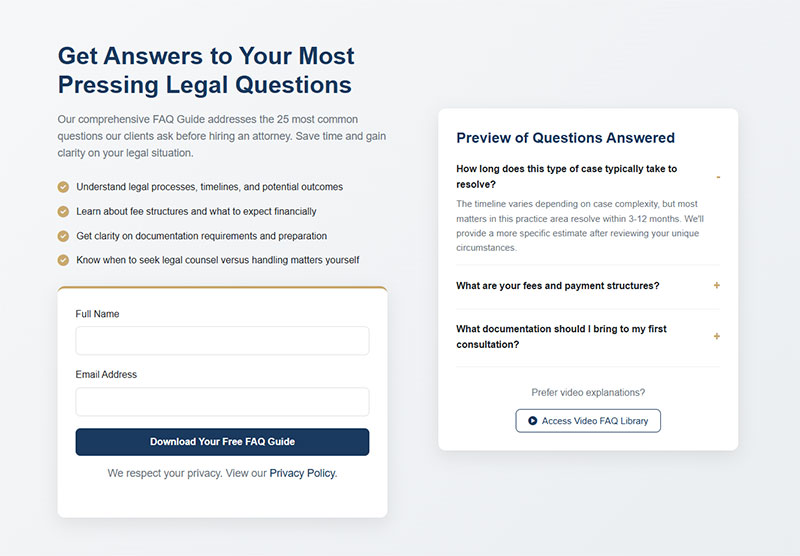
Addresses common questions efficiently while demonstrating comprehensive knowledge.
Target Audience
Information-seekers at various stages of decision process. People entering specific questions into search engines (question-based queries) make up primary audience.
Works for prospects comparing attorneys or validating information from other sources.
Content Format
Comprehensive Q&A document (15-30 questions) addressing common client concerns. Can be single PDF download or gated access to extensive online FAQ library.
Video FAQ formats perform increasingly well.
Value Proposition
Answers multiple prospect questions in single resource. Demonstrates anticipation of client needs and thoroughness of approach.
Strong FAQ guides often rank well in search engines for question-based queries.
Implementation Complexity
Low to moderate effort. Most attorneys already know common questions from intake calls and consultations.
Documenting those questions and writing clear answers requires 6-12 hours initially.
Conversion Mechanism
FAQ guides rarely drive immediate conversion but reduce friction in decision process. Prospects who understand process, costs, and timelines convert faster when ready.
Place consultation offers strategically after particularly complex or concerning questions.
Practice Area Fit
Universal application. Immigration law, family law, and personal injury particularly benefit since prospects have many procedural questions before hiring counsel.
Court Process Flowchart
Visual explanation that simplifies complex procedural information.
Target Audience
Prospects intimidated by legal processes. Criminal defendants, personal injury claimants, family law clients, and anyone facing litigation value clear process explanations.
Also useful for referral sources who need to explain processes to their own clients.
Content Format
Visual flowchart (single page or multi-page) showing typical case progression with timeframes, decision points, and potential outcomes at each stage.
Infographic style with icons, clear labeling, and minimal text works best.
Value Proposition
Reduces anxiety about unknown processes. Prospects understand what to expect, typical timelines, and their role in proceedings.
Flowcharts get saved, referenced repeatedly, and shared with family members involved in decisions.
Implementation Complexity
Moderate effort. Creating accurate flowcharts requires process documentation and design skills.
Free tools like Canva offer flowchart templates. Professional design might cost $150-300 from freelancers.
Conversion Mechanism
Downloaded flowcharts should include firm branding and consultation offer on every page. Process complexity revealed in flowchart often convinces prospects they need professional guidance.
Practice Area Fit
Criminal defense (court appearance timelines), family law (divorce process), personal injury (litigation stages), bankruptcy, and estate administration all benefit from process visualization.
Rights Infographic
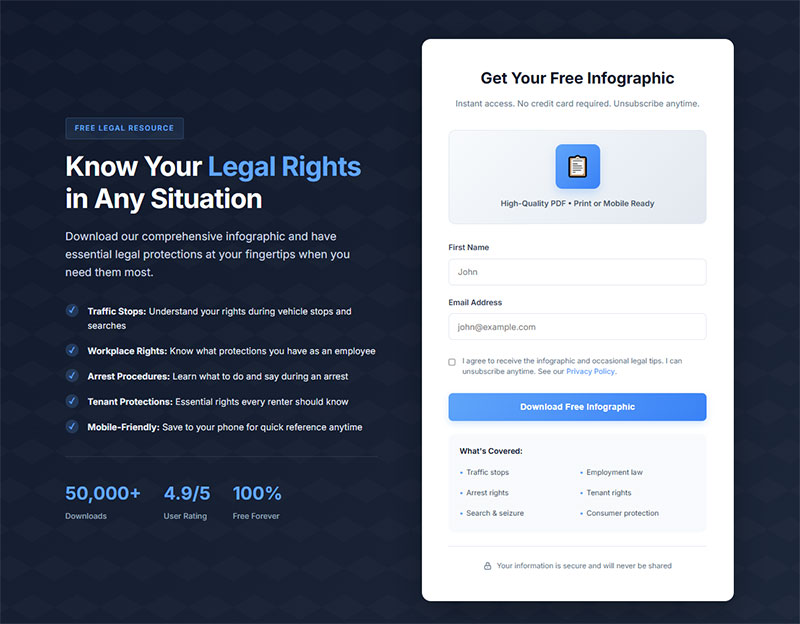
Quick-reference visual content that provides immediate practical value.
Target Audience
People who may not know their legal rights in specific situations. Traffic stop scenarios, workplace situations, arrest procedures, and tenant rights are commonly searched topics.
Mobile users particularly value one-page visual references.
Content Format
Single-page infographic suitable for printing, saving to phone, or sharing on social media.
Bold headers, concise bullet points, and clear visual hierarchy essential.
Value Proposition
Immediate practical utility that may be referenced in real-time during legal encounters. Highly shareable content that extends firm reach through social sharing.
Demonstrates commitment to public legal education and community service.
Implementation Complexity
Low to moderate. Research and design typically require 4-8 hours per infographic.
Templates from Canva or Piktochart reduce design time significantly.
Conversion Mechanism
Rights infographics generate awareness and goodwill more than immediate conversions. Include firm contact information prominently since references often occur during or after legal encounters requiring professional help.
Social media promotion expands reach exponentially compared to gated content.
Practice Area Fit
Criminal defense, employment law, tenant rights, consumer protection, and personal injury all benefit from rights education content.
Legal Toolkit
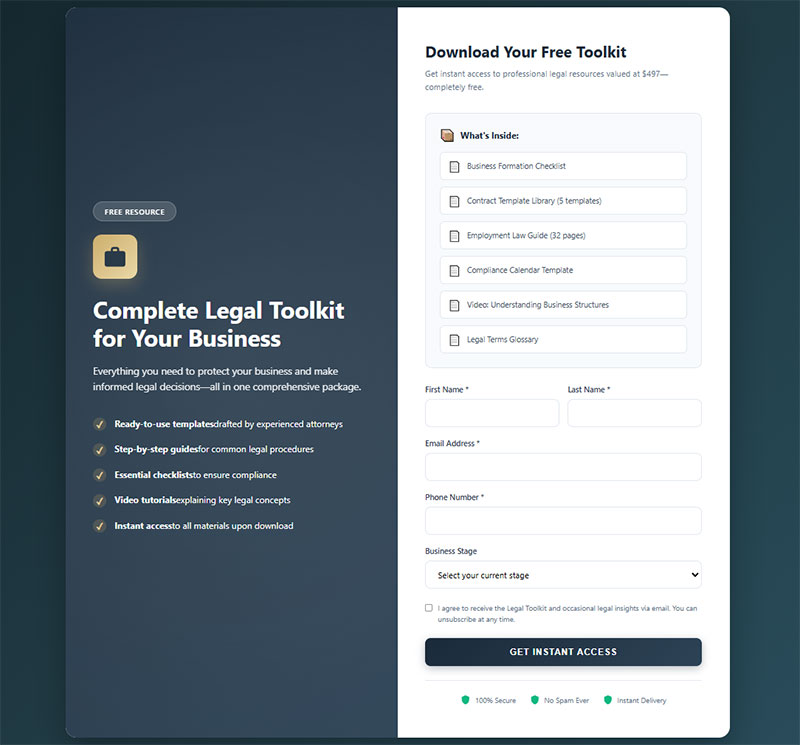
Comprehensive resource package combining multiple assets for higher perceived value.
Target Audience
Prospects willing to engage deeply with firm content. Small business owners starting ventures, individuals planning estates, or people facing major legal transitions value complete resource packages.
Content Format
Bundled package including checklist, template, guide, and possibly video resources addressing all aspects of specific legal situation.
Delivered as ZIP file or sequential email series unlocking resources over time.
Value Proposition
One-stop resource that addresses all prospect needs around specific topic. Higher perceived value than individual resources increases conversion willingness and initial engagement.
Demonstrates comprehensive understanding of client journey and needs.
Implementation Complexity
High effort but leverage existing content. Combining previously created resources into themed toolkits requires minimal additional work beyond packaging and description.
Creating entirely new toolkit from scratch demands 20-40 hours investment.
Conversion Mechanism
Toolkits justify higher ask, such as phone number in addition to email address. Sequential delivery over time (day 1: checklist, day 3: guide, day 7: templates) maintains engagement while preventing overwhelm.
Practice Area Fit
Business law (startup toolkit), estate planning (complete planning package), and real estate transactions all work well with comprehensive toolkit approaches.
Sample Contracts
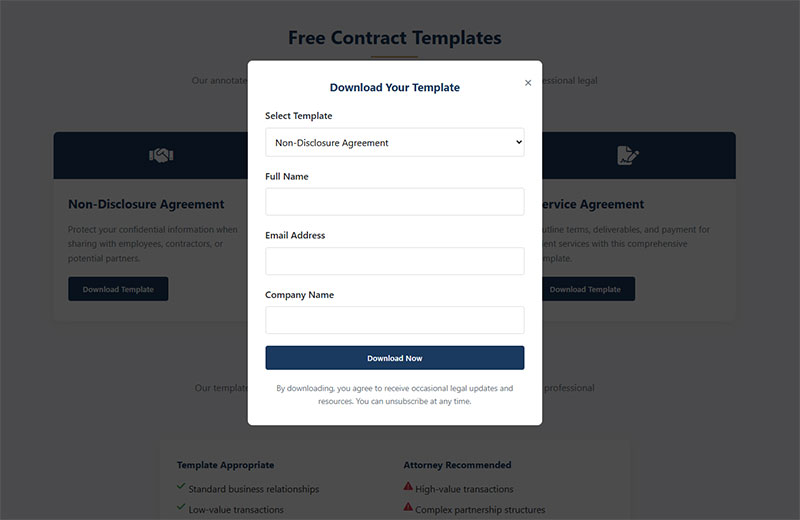
Demonstrates contract drafting expertise while providing immediate utility.
Target Audience
Business owners and entrepreneurs handling straightforward agreements independently. Startups, freelancers, and small businesses often start with templates before engaging attorneys for complex matters.
Content Format
Downloadable contract templates with clear annotations explaining each provision. Include guidance about when template suffices versus when attorney review becomes necessary.
Plain language explanations make legal provisions accessible.
Value Proposition
Real tool prospects can use immediately. Quality samples demonstrate drafting expertise and attention to detail that prospects notice.
Many who download samples eventually hire attorneys for customization or complex agreements.
Implementation Complexity
Moderate to high depending on complexity and jurisdiction. Legal review mandatory before distribution to ensure templates represent current law and don’t create liability.
Budget 8-15 hours for initial template creation including explanatory annotations.
Conversion Mechanism
Template users who encounter complex situations or need customization often return to source firm for paid services. Follow-up emails should highlight limitations of generic templates and situations requiring professional drafting.
Practice Area Fit
Business law (NDA templates, independent contractor agreements), real estate, and general contract review practices benefit most from sample contract strategies.
Statute of Limitations Calculator
Interactive tool providing immediate specific value to prospects.
Target Audience
Potential clients uncertain whether they can still pursue legal action. Personal injury victims, employment law claimants, and anyone with potential claims research limitation periods extensively.
Content Format
Online calculator collecting incident date, jurisdiction, and claim type, then providing deadline information with prominent disclaimers about exceptions and consultation recommendations.
Simple web form with database of limitation periods by claim type and state.
Value Proposition
Immediate specific answer to urgent prospect question. Limitation period concerns drive significant search traffic and represent prospects with high intent.
Calculators create urgency for prospects nearing deadlines.
Implementation Complexity
Moderate to high. Building accurate calculators requires extensive legal research across jurisdictions and claim types.
Technical implementation needs developer assistance unless using specialized calculator platforms. Plan for $500-2,000 development cost or 15-25 hours internal time.
Conversion Mechanism
Calculator results should strongly encourage consultation for accurate assessment, particularly for complex claims with exceptions or tolling provisions.
Urgent deadline situations convert at exceptionally high rates when followed up quickly.
Practice Area Fit
Personal injury, employment law, medical malpractice, and legal malpractice practices benefit significantly. Any practice area with statute of limitations concerns works well.
Case Study Collection
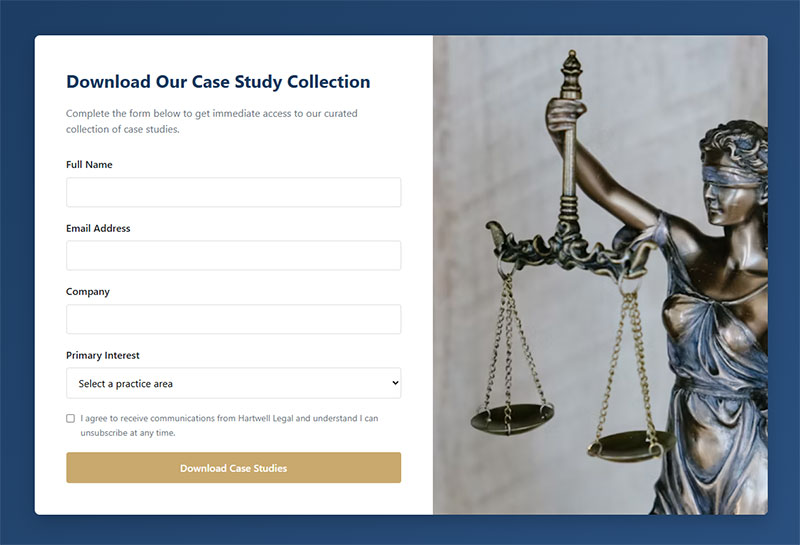
Social proof through detailed outcome descriptions builds credibility and sets expectations.
Target Audience
Prospects evaluating attorney capabilities and researching potential outcomes. Risk-averse clients and high-value cases particularly value case study review before engaging counsel.
Business clients accustomed to vendor evaluation through past work examples.
Content Format
Professionally written case summaries (3-6 per collection) describing situation, legal strategy, challenges overcome, and outcomes achieved.
Anonymize client details while preserving instructive elements. Include specific results where ethically permissible.
Value Proposition
Demonstrates real-world capabilities beyond credentials and marketing claims. Prospects see how firm approaches problems similar to their situations.
Case studies provide specificity that testimonials often lack.
Implementation Complexity
Moderate effort with ethical considerations. Each case study requires 3-6 hours to write properly, plus client permission to share details.
Review ethical rules about outcome claims and advertising restrictions in your jurisdiction before creation.
Conversion Mechanism
Case studies targeting specific claim types or client situations should gate content and deliver follow-up sequences highly relevant to reader’s demonstrated interest.
Prospects reading medical malpractice case studies should receive medical malpractice-focused follow-up.
Practice Area Fit
Personal injury, business litigation, employment law, intellectual property, and complex litigation practices benefit most from detailed case study approaches.
Email Course
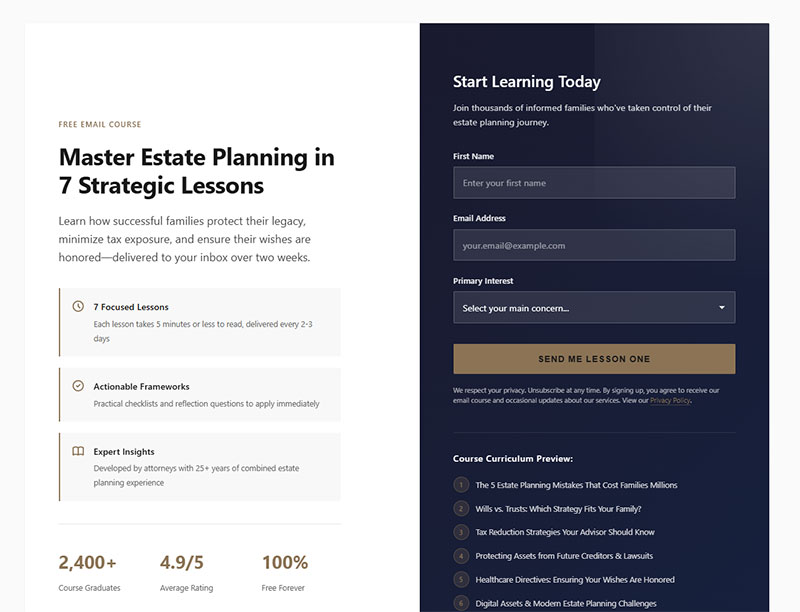
Sequential education that maintains engagement over extended period while building relationship.
Target Audience
Prospects at early research stages willing to invest time in education before making hiring decisions. Complex practice areas where client understanding improves engagement and outcomes work best.
Sophisticated clients who value education and strategic thinking.
Content Format
Series of 5-10 emails delivered over 1-3 weeks, each covering specific aspect of legal topic. Each lesson should be consumable in 5 minutes or less.
Include practical exercises, reflection questions, or action items when appropriate.
Value Proposition
Extended engagement period builds relationship before consultation request. Sequential learning creates anticipation and habit around firm communications.
Email courses position attorneys as educators rather than salespeople, building trust organically.
Implementation Complexity
Moderate initial effort with ongoing automation benefits. Creating 5-10 email lessons requires 12-20 hours initially but becomes evergreen asset requiring minimal maintenance.
Email service provider with automation capabilities required.
Conversion Mechanism
Consultation offers should appear strategically throughout course, typically after establishing sufficient value and authority. Final emails should include clear conversion pathway.
Course graduates become highly qualified leads familiar with firm’s communication style and expertise.
Practice Area Fit
Estate planning, business formation, intellectual property strategy, and employment law for employers all work well with educational course approaches.
Podcast Series
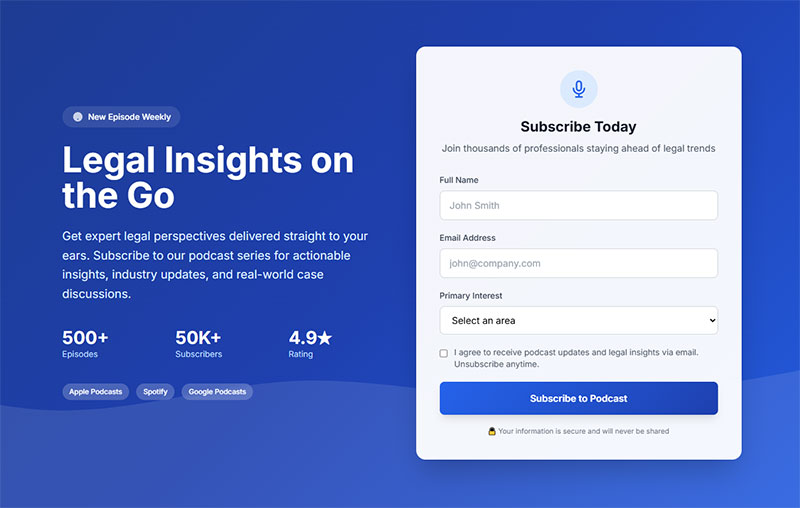
Audio content for prospects consuming information during commutes, exercise, or downtime.
Target Audience
Mobile audiences, commuters, and prospects preferring audio content over written materials. Professional audiences (business owners, HR managers, executives) often consume podcasts during activities incompatible with reading.
Younger demographics increasingly prefer audio content.
Content Format
Regular podcast episodes (15-30 minutes) covering legal topics, interviewing guests, or answering listener questions.
Host on podcast platforms (Apple Podcasts, Spotify) plus firm website.
Implementation Complexity
High initial investment but decreasing barriers to entry. Podcasting requires audio equipment ($150-500 for decent setup), editing software, hosting platform, and consistent content creation.
Each episode demands 3-6 hours for planning, recording, editing, and promotion.
Conversion Mechanism
Podcast listeners become highly familiar with attorney personality, expertise, and communication style before first contact. Include consultation offers in show notes and periodic episodes.
Listener relationship feels personal despite one-to-many format, creating strong foundation for retention.
Practice Area Fit
Business law, employment law, estate planning, and intellectual property work well with podcast formats. Practice areas where ongoing legal developments create regular content opportunities see best results.
Legal Blog Access
Ongoing content library demonstrating expertise across multiple topics.
Target Audience
Search engine users researching specific legal questions. Blog content captures organic search traffic for thousands of long-tail queries over time.
Prospects at various stages of decision process all benefit from educational blog content.
Content Format
Regular blog posts (800-2,000 words) addressing specific legal topics, questions, or developments. Some firms gate premium content while leaving basics freely accessible.
SEO optimization critical for traffic generation.
Value Proposition
Answers specific prospect questions while demonstrating breadth and depth of expertise. Blog content compounds value over time as posts continue generating traffic years after publication.
Cost per lead decreases dramatically as content library grows.
Implementation Complexity
Moderate ongoing effort. Each blog post requires 3-6 hours for research, writing, and optimization.
Consistency matters more than volume. Plan sustainable publishing schedule (weekly or biweekly minimum).
Conversion Mechanism
Blog posts should include clear calls to action directing readers to consultations, lead magnets, or contact forms. High-performing posts warrant dedicated landing pages for maximizing conversion.
Email capture offers integrated into blog content convert readers into leads for ongoing nurturing.
Practice Area Fit
Universal application. All practice areas benefit from educational content addressing common prospect questions and concerns.
FAQ on Lead Magnets For Law Firms
What exactly is a lead magnet in legal marketing?
A lead magnet is free content you offer website visitors in exchange for their contact information. Think legal guides, checklists, case evaluations, or consultation offers.
The goal? Capture email addresses from prospects who aren’t ready to hire immediately. These leads enter your marketing funnel where you can nurture them until they need legal services.
How much do law firm lead magnets typically cost to create?
Simple checklists or templates cost almost nothing beyond your time (4-8 hours). Professionally designed ebooks run $200-500 if outsourcing design work.
Video content and webinars demand more investment. Budget $500-2,000 for quality video production or hire freelancers on Upwork for less. Your biggest cost is always attorney time, not money.
Which lead magnet converts best for law firms?
Checklists consistently outperform other formats. They’re quick to consume, immediately useful, and get shared frequently.
Free consultations convert highest among prospects ready to hire now. But conversion rate alone misleads since different lead magnets attract prospects at different stages. Estate planning guides might convert at 3% while consultations hit 30%, but guides reach 10x more people.
Do I need different lead magnets for each practice area?
Yes. Generic “understanding the law” content gets ignored.
Personal injury prospects want accident checklists and case value calculators. Business clients need operating agreement templates and compliance guides. Family law searchers look for divorce process timelines. Match your lead generation form offers to specific practice area questions people actually search for.
How do I promote my law firm’s lead magnet?
Place offers on relevant website pages where prospects already research those topics. Add exit-intent popups when visitors prepare to leave your site.
Promote through Google Ads targeting question-based searches, share on LinkedIn and social media, include in email signatures, and feature in blog post content upgrades. Multiple promotion channels outperform relying on single tactics.
What information should I collect on lead capture forms?
Start with email address only. Adding fields decreases conversion rates significantly.
Name helps personalize follow-up but isn’t mandatory initially. Phone numbers and detailed case information work better for high-value offers like free consultations or case evaluations. Test adding fields gradually while monitoring how form fields affect conversion rates.
How quickly should I follow up with lead magnet downloads?
Immediately. Send automated welcome email within 60 seconds of download containing the promised resource plus next steps.
Personal follow-up should happen within 5 minutes for consultation requests. Research shows firms responding within five minutes convert leads 21 times more effectively than those waiting 30 minutes. Speed matters more than perfect messaging.
Can I use AI to create lead magnets faster?
AI handles research compilation, first drafts, and outline creation efficiently. But generic AI content gets ignored.
Use AI for initial structure, then add your specific case examples, jurisdiction details, and practice insights. Never publish AI-generated legal content without attorney review. Your expertise and local knowledge differentiate your lead magnets from competitors using identical AI prompts.
Should lead magnets be gated or freely accessible?
Gate high-value resources requiring email capture to build your marketing database. Leave basic educational blog content ungated for search engine visibility.
The trade-off: gated content reaches fewer people but captures qualified leads. Ungated content drives more traffic and brand awareness without direct conversion. Most firms benefit from mixing both approaches strategically.
How do I measure if my lead magnet is working?
Track download conversion rate (visitors to downloads), email open rates, consultation booking rate from email sequences, and ultimately retained clients from each lead source.
Most firms ignore the full funnel and only count immediate conversions. But someone downloading your estate planning guide today might hire you in six months. Use proper form validation to ensure clean data for accurate tracking over time.
Conclusion
Lead magnets for law firms stop the bleeding that happens when qualified prospects visit your website and leave without converting. Most attorneys lose 95% of traffic this way.
Start small. Pick one practice area and create a simple checklist or guide addressing the most common questions you hear during intake calls.
Gate it behind a basic contact form and promote it on relevant pages. Test what converts. Then expand to other practice areas.
The firms winning client acquisition battles aren’t necessarily better lawyers. They’re better at staying visible while prospects research options, compare attorneys, and eventually make hiring decisions.
Your expertise means nothing if potential clients can’t remember your name when they’re ready to hire. Free resources solve that problem by building your email list today and generating consultations for months afterward.
Digital marketing for attorneys isn’t optional anymore. Client intake starts with capturing contact information from website visitors before they disappear to competitors.


